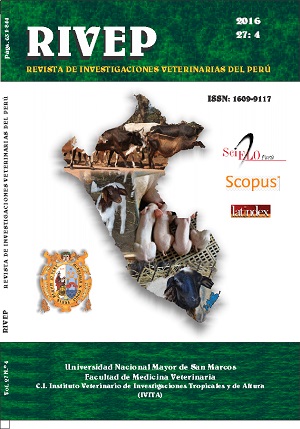Rostrotentorial decompressive craniotomy in a breeding ram
DOI:
https://doi.org/10.15381/rivep.v27i4.12577Keywords:
craniotomy, ovine, intracranial hypertension, tumourAbstract
This study aimed to discuss the results of a rostrotentorial decompressive craniotomy performed in a ram with had severe neurological signs. The patient had a clinical picture of right paresis product of a left hemisphere syndrome. A computerized axial tomography (CAT) was conducted and a tumour was found in the left cerebral hemisphere. In order to extend the productive life of the animal, given his value as a sire, a decompressive craniotomy was performed. Part of the cranial vault was dissected to provide more space to the brain and relieve intracranial hypertension caused by this pathology. Once recovered from anaesthesia, the animal presented a remission of neurological signs. The patient did not present the previous compulsive circling behaviour, ataxia and head-pressing behaviour. The patient remained under observation for a period of 20 days, during which he presented good temper and appetite. The results of the surgery showed the possibility of using this technique for the relief of neurologic clinical signs in animals suffering cerebral neoplasia, cerebral oedema, cerebral bruises or coenuruses.Downloads
Downloads
Published
Issue
Section
License
Copyright (c) 2017 Rocío Silvia Sandoval Monzón, Luis Felipe Ruiz García, Eben Amed Salinas Campos, Willy Mayk Victorio Cisneros

This work is licensed under a Creative Commons Attribution-NonCommercial-ShareAlike 4.0 International License.
AUTHORS RETAIN THEIR RIGHTS:
a. Authors retain their trade mark rights and patent, and also on any process or procedure described in the article.
b. Authors retain their right to share, copy, distribute, perform and publicly communicate their article (eg, to place their article in an institutional repository or publish it in a book), with an acknowledgment of its initial publication in the Revista de Investigaciones Veterinarias del Perú (RIVEP).
c. Authors retain theirs right to make a subsequent publication of their work, to use the article or any part thereof (eg a compilation of his papers, lecture notes, thesis, or a book), always indicating the source of publication (the originator of the work, journal, volume, number and date).










